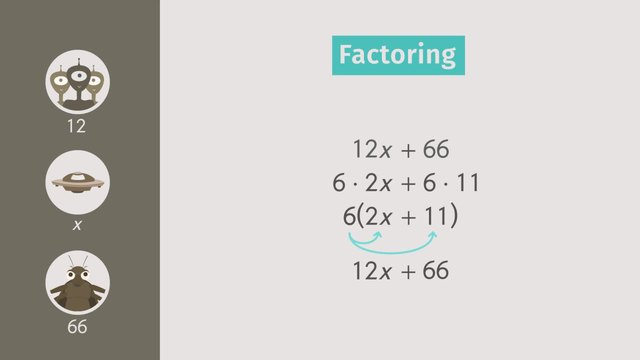What is Factoring?


Basics on the topic What is Factoring?
The process of writing a polynomial as a product is called factoring. Finding and factoring out the greatest common factor of a polynomial is the first step when factoring, and so it can be an important part of simplifying an expression. Factoring allows one to break down a complicated polynomial into much simpler expressions whose structures are easier to work with. Learn how to factor polynomials by helping Ralph Kakerlake design a sports tournament program to build interplanetary relations among participating planets in the annual Confederation of United Planets (CUP). Common Core Reference: CCSS.MATH.CONTENT.6.EE.A.3
Transcript What is Factoring?
This is the year for Planet X to host the annual Confederation of United Planets, better known as CUP. The invitations have been sent out by spaceship which will soon return filled with aliens from many different planets. Everything is almost ready, but Ralph Kakerlake is still finishing his work. He's deciding on some activities the aliens can do during their free time. To keep everything fair, he'll have to use factoring to decide on the program. But, what is factoring? First, Ralph wants to build interplanetary relations by holding a sports tournament where each team is made up of aliens from different planets. Ralph wants to make sure each team has the same number of players. The number of players per team will determine which sports they can play. Ralph knows each spaceship holds 12 aliens. Unfortunately, he doesn’t know how many planets will accept the invitation. Since he's not sure how many planets will send back spaceships, let’s use the variable 'x' to represent the number of spaceships that return. Ralph also has to include the 66 ambassadors from the host planet. Therefore, the number of participants will be 12x plus 66. Now that Ralph has an expression representing the number of participants, he wants to divide these aliens into groups of equal size. This way, he’ll know which sports they can play. In order to divide the aliens into groups of equal size, Ralph will have to use factoring. First, Ralph has to look for the greatest common factor, or GCF, of 12x and 66. In this case, it's 6. This is the largest number that goes evenly into both 12 and 66. Therefore, we can factor a 6 out of the expression. The expression becomes 6 times the quantity 2x plus 11. You can think about this as reverse distribution because if you were to distribute the 6 to the 2x plus 11, you would get the original expression, 12x plus 66. Since 6 can be factored out of the expression, this means that no matter how many planets accept the invitation, they can always split the aliens into equal groups of 6. That's perfect for playing slamball, which is similar to the basketball they play on Earth. After playing slamball, Ralph wants to set up a special 3 on 3 slamball tournament. But how big should the groups be? Ralph decides to only let the senior ambassadors perform in this exclusive event. This means that there will be 6 participants from each planet that accepts the invitation, plus 15 members from the host planet. He can represent this using the expression 6x+15, where x is still the unknown number of planet that will accept the invitation. Ralph wants to split these members in to groups of equal size. He realizes that he can factor a 3 out of the expression 6x+15, because 3 goes evenly into both 6 and 15. After factoring out 3, the expression becomes 3 times 2x plus 5. This means that no matter how many planets accept the invitation, they will be able to split the aliens into groups of 3. All of the spaceships have arrived to Planet X, and it looks like every planet sent their 12 representatives. Ralph's math was correct, so he randomly divides the aliens into teams of 6 for slamball and groups of 3 for the special tournament. They start off with slamball. As the teams are formed, Ralph realizes that even though his math was right, it looks like the teams might be a little uneven. Not all aliens have the same talents...
What is Factoring? exercise
-
Recall the steps for factoring an expression.
HintsPay attention to the paranthesis.
You can check the factorization. Let's have a look at the following example: $6+8x=2(3+4x)$.
You can use the distributive property to check your answer: $2(3+4x)=(2)(3)+(2)(4x)=6+8x$. ✓
To get the greatest common factor, just multiply all common factors.
SolutionThe is the expression for the total of aliens is $12x+66$.
To decide which sports they could do, he must divide the aliens into groups of equal size.
First, Ralph has to look for the greatest common factor of $12x$ and $66$:
- $12x=(2)(2)(3)(x)$
- $66=(2)(3)(11)$
So we can factor $6$ out of the expression to get $6(2x+11)$.
You can check this factorization using the distributive property:
$6(2x+11)=(6)(2x)+(6)(11)=12x+66$.
That's it.
-
Factor the expressions.
HintsKeep the commutative property in mind. The order of multiplication can be changed:
$a\times b=b\times a$.
The input is clear depending on the parentheses and the factor $x$.
Just look at this example.
The greatest common factor of $12x$ and $8$ is $4$.
You can check your factorization using the distributive property.
SolutionHere you see the solution. The expression $6x+15$ should be factored out.
First, we factor both terms:
- $6x=2\times 3\times x$ and
- $15=3\times 5$
$6x+15=3\times 2x+3\times 5$.
Now we can factor out $3$ to get $3(2x+5)$.
You can check this factorization using the distributive property.
$3(2x+5)=(3)(2x)+(3)(5)=6x+15$ ✓
-
Identify the expressions that are factored completely.
HintsCheck each factorization by using the distributive property.
Just look at the example beside.
Make sure to factor out the greatest common factor.
Sure $8x-12y=2(4x-6y)$ and $2$ is a common factor of $8x$ and $12y$. But it isn't the greatest common factor.
SolutionPoor Ralph. He's a little bit stressed. He has to factor out a lot of expressions and he should be absolutely concentrated... but he keeps getting distracted.
Let's help him out by helping him to find his mistakes.
First, let's look at $\mathbf{24x+16}$. We have that
- $24x=2\times 2\times 2\times 3\times x$
- $16=2\times 2\times 2\times 2$
$24x+16=8\times 3x+8\times 2=8(3x+2)$.
Just have a look at another example: $\mathbf{8x^2+24x}$. We have that
- $8x^2=2\times 2\times 2\times x\times x$
- $24x=2\times 2\times 2\times 3\times x$
$8x^2+24x=(8x)(x)+(8x)(3)=8x(x+3)$.
To get a better feeling in your factoring skills, just check the calculations using the distributive property.
-
Construct and factor the corresponding expressions.
HintsAssign the variable $x$ to the unknown values.
Let's have a look at an example. If Lisa buys $4$ muffins with an unknown price $x$ and coffee for $4$ dollars, we get the expression $4x+4$.
The greatest common factor of $4x$ and $4$ is $4$ itself:
$4x+4=(4)(x)+(4)(1)=4(x+1)$.
SolutionHere we first have to establish the algebraic expression. After that, we factor out the greatest common factor.
$~$
Paul
He buys three pairs of shoes for an unknown price, $x$. This leads to $3x$. The price of the headphones must be added. The resulting expression is $3x+48$. The greatest common factor is $3$:
$3x+48=(3)(x)+(3)(16)=3(x+16)$.
$~$
Monica
She spends a lot of time doing her homework, six hours per assignment. The corresponding expression is $6x$. Next we add the total time for sports and get $6x+12$. Here we have the greatest common factor $6$, which we can factor out:
$6x+12=(6)(x)+(6)(2)=6(x+2)$.
$~$
Matteo
Each taco costs $4$ dollars. Because the number of sold tacos is unknown, we assign the variable $x$ to it. The fix delivery cost is added to get $4x+200$. The greatest common factor is $4$:
$4x+200=(4)(x)+(4)(50)=4(x+50)$.
-
Identify the GCF between the pairs of numbers.
HintsYou find the greatest common factor by factoring both numbers.
Here is the factorization of $24$.
Factor both numbers and then check for common factors:
- $24=\mathbf{2}\times \mathbf{2}\times \mathbf{2}\times 3$
- $16=\mathbf{2}\times \mathbf{2}\times \mathbf{2}\times 2$
The greatest common factor is the product of the highlighted factors:
$2\times 2\times 2=8$.
SolutionTo find the greatest common factor, you factor the given terms and check for common factors among the terms. If the terms have more than one factor in common, the greatest common factor is the product of those factors.
Let's have a look at a few examples:
$12$ and $8$:
- $12=2\times 2\times 3$
- $8=2\times 2\times 2$
$12$ and $9$:
- $12=2\times 2\times 3$
- $9=3\times 3$
$30$ and $24$:
- $30=2\times 3\times 5$
- $24=2\times 2\times 2\times 3$
$25$ and $10$:
- $25=5\times 5$
- $10=2\times 5$
-
Decide how to factor the expressions.
HintsDetermine the greatest common factor for the term of each expression.
Let's have a look at an example: $15x^2-10x+5x^3=(5x)(3x)-(5x)(2)+(5x)(x^2)$.
The greatest common factor is $5x$.
If $5x$ is the GCF of $15x^2-10x+5x^3$, then we can factor it out to get $(5x)(3x)-(5x)(2)+(5x)(x^2)=5x(3x-2+x^2)$.
SolutionFor each example, let's first look for the greatest common factor for all terms in the expression. Then we factor out the greatest common factor:
$12x+6y+36=(6)(2x)+(6)(y)+(6)(6)=6(2x+y+6)$
$12x^2+6x-36x^3=(6x)(2x)+(6x)(1)-(6x)(6x^2)=6x(2x+1-6x^2)$
$24y-12x^2+18=(6)(3y)-(6)(2x^2)+(6)(3)=6(3y-2x^2+3)$














